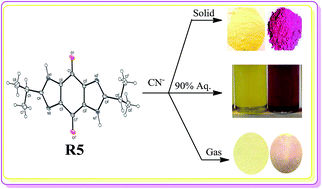Benzoquinone–imidazole hybrids as selective colorimetric sensors for cyanide in aqueous, solid and gas phases†
Abstract
Five new chemosensors (R1–R5), possessing benzoquinone as the signaling unit and imidazole as the H-bond donor unit, for cyanide sensing have been rationally designed, synthesized and characterized by NMR and mass spectroscopy. The structure of R5 was confirmed by single crystal XRD studies. These receptors exhibited a prominent visual colour change toward the cyanide ion over other common anions in an aqueous HEPES buffer–DMF (9 : 1 v/v) medium. The complexation of receptor–CN− has been addressed by UV-Vis, fluorescence and 1H NMR spectra and was supported by electrochemical and DFT studies. The mechanism of sensing involves formation of H-bonds between imidazole N–H and CN− ions. The stoichiometry of the receptor–CN− complexes was found to be 1 : 2 (receptor–CN−) and the detection limit was observed to be in the range of 1.1–3 nM. The test strips based on R5 were fabricated and could act as convenient and efficient CN− test kits. Notably, the novelty of the present investigation is that the receptor R5 selectively senses CN− ions in solid, aqueous and gas phases i.e. ‘a complete receptor’.


 Please wait while we load your content...
Please wait while we load your content...